Tracing the Legacy of Slavery in America Through Sculpture

- Oops!Something went wrong.Please try again later.
- Oops!Something went wrong.Please try again later.
"Hearst Magazines and Yahoo may earn commission or revenue on some items through these links."
When Bryan Stevenson first saw artist Simone Leigh’s sculpture Brick House at the 2022 Venice Biennale in Italy, he saw his grandmother. “The first thing I wanted to do was run and embrace it,” he says, recalling later to Leigh that he hadn’t known he was looking for his grandmother until he saw her piece. “Simone allowed me to find her in something big and Black and beautiful and bold—so I knew I wanted that at the beginning.”
Stevenson is executive director of the Equal Justice Intiative, a nonprofit committed to ending mass incarceration, which he founded in 1989 as an extension of his law practice representing people on death row. “The beginning” he is referencing is the entrance to the Freedom Monument Sculpture Park in Montgomery, Alabama, a 17-acre site that physically walks visitors through the United States’ history, from enslavement to emancipation, with sculpture, testimonials, and historical artifacts including 170-year-old plantation dwellings of enslaved people and life-size “last seen” ads in which Black people requested information about family members from whom they had been forcibly separated. The park, which opened March 27, is the third in a series of EJI spaces in Montgomery, following in the footsteps of the Legacy Museum—which traces slavery’s evolution across racial segregation, lynchings, and mass incarceration—and the National Memorial for Peace and Justice—which pays homage to the thousands of Black Americans who were victims of domestic terrorism by way of sanctioned, racial terror lynchings.
In keeping with Stevenson’s belief in “authenticity of place,” or the value of sharing history in the very environment where it happened, EJI intentionally situated the park between the Alabama River and the state’s rail lines, both prominent channels that catalyzed and sustained the kidnapping and brutalization of enslaved people. (By 1860, nearly 400,000 Black people had been enslaved on or near the Alabama River.) “To have the same space—where, for generations, the history of the Civil War was dictated by the losers in a way that continued to oppress a large portion of the population—be used as a new landscape for storytelling, one that becomes a major driver of tourism and economic growth in the region, is deeper than anything I could imagine,” says Hank Willis Thomas, one of more than 30 artists featured at the new site.
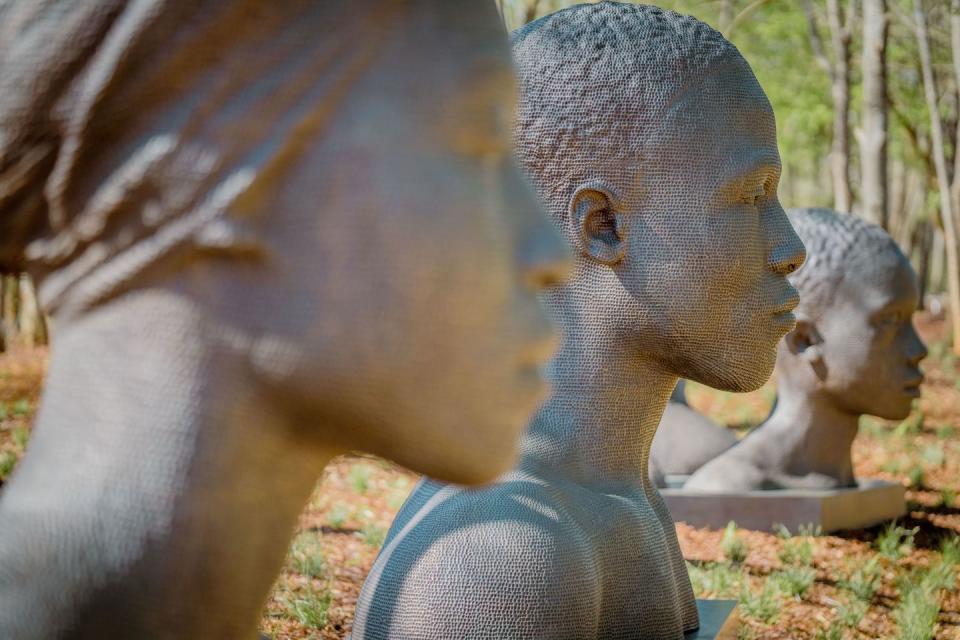
Freedom Monument Sculpture Park visually articulates the gravity of loss that stemmed from Europeans’ mass abduction of African communities, while paying homage to the millions of Black people who somehow maintained their capacity to love and hope for freedom along the way. “Each piece is designed to animate and dramatize the narrative,” says Stevenson, “and the narrative is designed to provide context for the pieces.” What this looks like in practice is a two- to three-hour, art-filled, walkable loop, starting with pieces by Indigenous artists like Allan Houser, whose parents were jailed in Montgomery like many other Indigenous people who tried to resist their forced removal. (Between 1813 and 1836, 16,000 Muscogee people were forcibly removed from their Alabama homelands.) It looks like busts by Rayvenn Shaleigha D’Clark, which—paired with text that details African advancements within metallurgy or specialization in growing rice and sugar—counter the harmful myths that African countries were underdeveloped or that slavery was beneficial to Black people. It looks like Brad Spencer’s figure-shaped brick sculptures, sitting next to text reading: “the tiny fingerprints of enslaved children who turned bricks as they dried can be seen today on the bricks of historic Charleston buildings.” In conversation, these artworks reflect the interconnected methods of Black oppression that persist to this day, methods we can quite literally see at work by way of, say, children’s fingerprints.
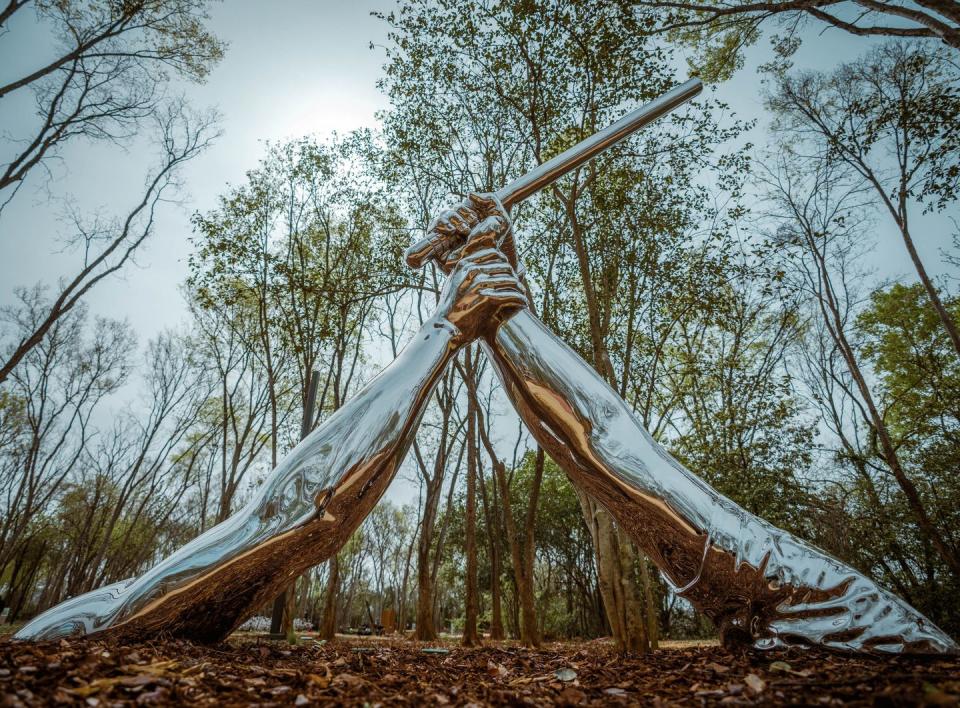
Stevenson believes that pairing such pieces allows them to “have a power they might not otherwise have.” “Hank’s visual depiction of violence [in his sculpture Strike], next to Rashid [Johnson’s] boat, next to a whipping post across from a holding pen—it allows you to see the full beauty of the work,” he says. Ghanaian multidisciplinary artist Kwame Akoto-Bamfo, whose work is also featured prominently at EJI’s two other sites, speaks to this relationship within his own sculptures in the park. If you look closely at his two bronze, multi-figured installations, you can see that characters from We Am Very Cold (which appears first) are once again present in Mama, I hurt my hand, identifiable only by a mark of the Yoruba tribe here or a forehead scar there. “We should become conscious that this is a continuum,” Akoto-Bamfo says of his works’ connectedness. “Bryan uses [the term] selective amnesia—we like to forget or cut things off, but it is a continuum; and you and I, we all play a part of this narrative.”
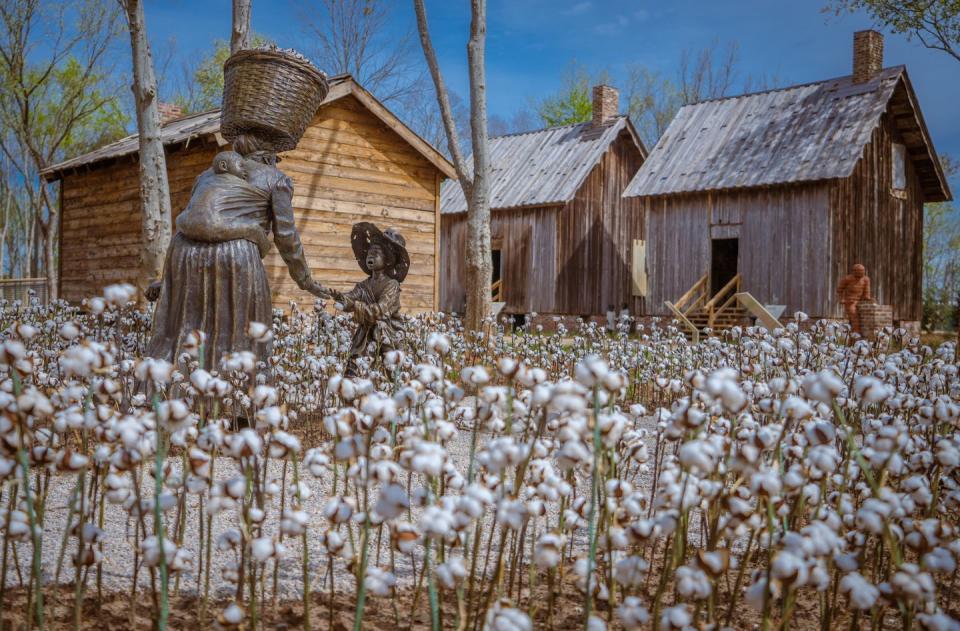
Together, the park’s artworks push back against the archaic right-wing talking point that slavery has always been around and was not unique to the European slave trade. Visitors can see the translatlantic and domestic slave trade represented “something very different than slavery that was a consequence of losing a war or being in debt,” Stevenson says. “It became racialized, it became permanent, and it became hereditary.” Stevenson has long underscored the integral role visuals play in “exposing who is the villain and who is the hero.” “When law enforcement officers are beating and battering and bloodying women on their knees praying, the optics shift,” he says. In this way, Stevenson is a conceptual artist, says Thomas, who uses the term to describe his own work as well. “Every law practice is inherently a creative practice,” Thomas says. “And for Bryan to do in this landscape what he cannot do in the courtroom is really a testament to how brilliant of an artist he is.”
In the same breath that the park documents the generational violence against Black people since enslavement, it also “celebrates this community of people who did something so remarkable” in their survival, Stevenson says. This approach is a relief to artists like Akoto-Bamfo, who calls working with EJI “a canvas of peace.” “I can vent in the works, show the harshness, be explosive, but I don’t want it to end in violence,” he says. “I know Bryan will make sure there is closure or a way forward for people who visit.”
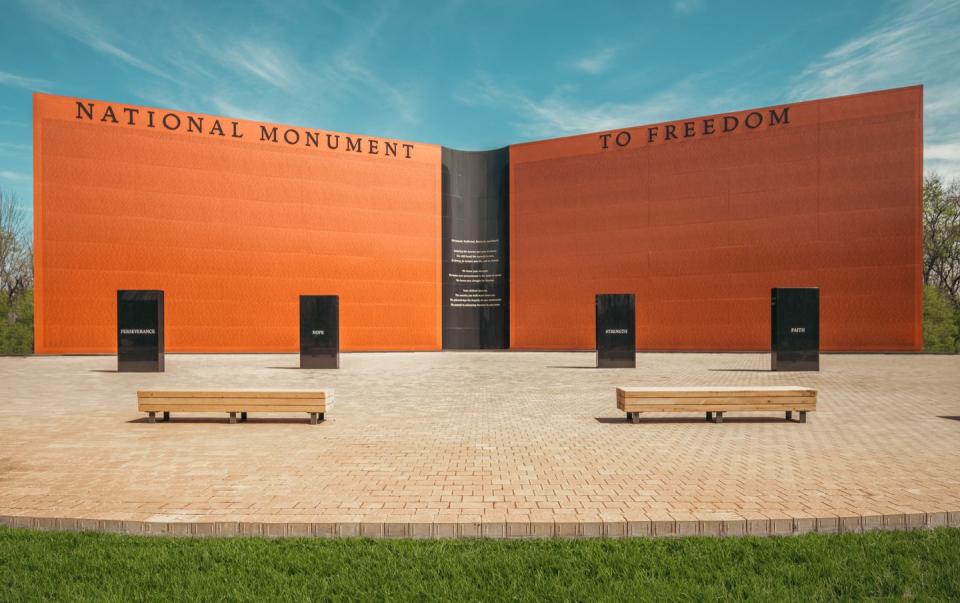
Visitors might feel this sense of healing or closure at the final stop in the park, the 43-by-155-foot National Monument to Freedom. According to Stevenson, who conceived of the piece, its impetus was to “talk about the extraordinary things that ordinary people did, even people whose names we don’t know.” Covered in over 120,000 names adopted by nearly five million formerly enslaved Black people (derived from the 1870 Census), the monument speaks directly to tho whose histories visitors have just witnessed. It reads:
Kidnapped, Trafficked, Enslaved, and Abused
Enduring the horrors and pain of slavery,
You still found the capacity to love,
to dream, to nurture new life, and to triumph.
We honor your strength.
We honor your perseverance in the midst of sorrow.
We honor your struggle for freedom.
Your children love you.
The country you built must honor you.
We acknowledge the tragedy of your enslavement.
We commit to advancing freedom in your name.
Unfortunately, the last three lines sound like battles we are still very much fighting—which is, of course, an integral point of the EJI sites. “We’re not going to get where we’re trying to go if there’s no repair or remedy to these harms,” Stevenson says. “If we can create a consciousness—if we can turn a city with this long history of denial and silence into a place of truth telling and progress—there’s not another community in America that can say, ‘Oh, well, they could do that in Montgomery, but we can’t do that here.’ ” Part of EJI’s work beyond the physical sites in Alabama is activating other communities to participate in constructing their own public markers, most specifically at lynching sites in their areas. (The most recent effort was in Newton, Mississippi.)
Through this work, communities are practicing accountability for enslavement—both in the past and in its current form. With a 13th Amendment that abolishes slavery “except as a punishment for crime,” the United States continues to rely on the nearly-free labor, confinement, and surveillance of people—primarily Black people—in service of capital through mass incarceration. Stevenson believes that “there’s another way of achieving accountability than just throwing people away and acting like we can be as abusive toward this person who committed a crime as the crime that they committed.” EJI has long fought to expel systemically violent practices from our criminal legal system, like legislation that allowed for death sentences or life without parole for children. “If the vision is to have healthy communities where people are not struggling with trauma or addiction or any of the things that feed violence,” Stevenson says, “EJI is making the case that putting children in adult prisons isn’t the way to do that, that executing people is not the way to do that, and that giving up on people is not the way to go.”
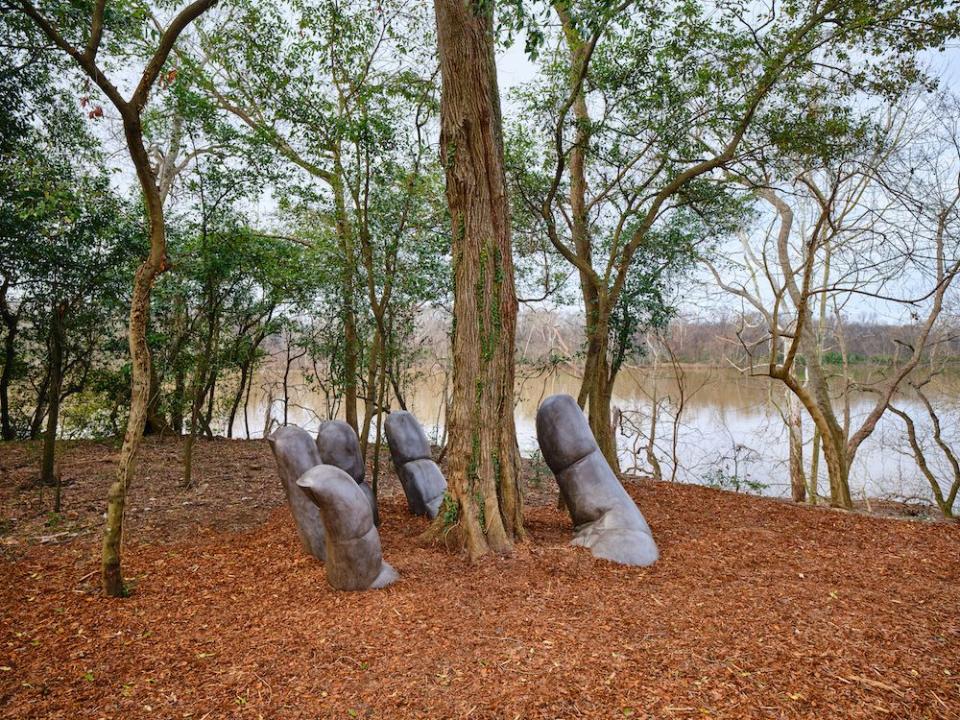
But political figureheads are more interested in regression: States like Alabama and Louisiana recently sanctioned the murder of people on death row by nitrogen gas. (One in eight people on death row has been exonerated, and Black people are overrepresented there, making up 42 percent of the population awaiting execution.) Unfortunately, these representatives are not limited to state leadership. “For the first time in my life, we don’t have a court that’s committed to advancing racial justice along this continuum—they’re actually trying to retreat,” Stevenson says of the U.S. Supreme Court, whose conservative majority ruled against affirmative action last year. With this court at the helm of the justice system, and with two million people currently incarcerated, it appears that this country defines its greatness by the degree to which it punishes and limits Black people.
But, bolstered by their historical sites, Stevenson and the team at EJI are intent on fighting these structures in the movement toward liberation. “I have to be willing to believe things I haven’t seen—otherwise, I will be doomed by the landscape that’s in front of me,” he says. Evoking Martin Luther King Jr., he adds that we “have to resort to a sort of moral power, [one that] can’t be given to you by a politician, by a gun or a weapon, or by wealth.” Hopefully, he says, this power will encourage people—white people especially—to subscribe to the words centered on the park’s National Monument to Freedom. By emblematizing accountability at its sites, EJI is speaking to Americans that deny our history—saying, in Stevenson’s words: “You’re more than an enslaver or a lyncher. And if I can extend that grace to you, then we need you to extend that to people who … are often the victims of a lot of these institutions that you created.”
You Might Also Like

